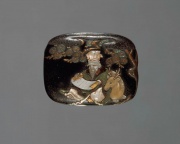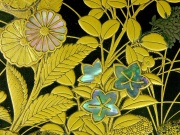Difference between revisions of "Mother-of-pearl"
(username removed) |
(username removed) |
||
| Line 2: | Line 2: | ||
== Description == | == Description == | ||
| − | A hard, iridescent inner layer of some mollusk shells, including abalone, snails, pearl oyster, and mussel. Mother-of-pearl, or nacre, is primarily composed of [http://cameo.mfa.org/materials/fullrecord.asp?name=calcium | + | A hard, iridescent inner layer of some mollusk shells, including abalone, snails, pearl oyster, and mussel. Mother-of-pearl, or nacre, is primarily composed of [http://cameo.mfa.org/materials/fullrecord.asp?name=calcium%20carbonate calcium carbonate] in the crystalline form of [http://cameo.mfa.org/materials/fullrecord.asp?name=aragonite aragonite]. The crystals are held together with [http://cameo.mfa.org/materials/fullrecord.asp?name=conchiolin conchiolin]. Pearls are composed of the same material. The color of the nacre can be white, yellow, green, blue, pink, or purple depending of the species of mollusk and the temperature of the water. Warm, equatorial seas tend to produce mollusks with darker or brighter colors. Mother-of-pearl has been used for jewelry since 3000 BCE. It has also been used for decorative inlays, knife handles, cameos, buttons, and beads. |
[[File:11.10161_det3.jpg|thumb|Mother of pearl]] | [[File:11.10161_det3.jpg|thumb|Mother of pearl]] | ||
== Synonyms and Related Terms == | == Synonyms and Related Terms == | ||
| − | mother of pearl; nacre (Fr.); pearl shell; madreperla (Esp.); | + | mother of pearl; nacre (Fr.); pearl shell; madreperla (Esp.); madrepérola (Port.); parelmoer (Ned.) |
== Other Properties == | == Other Properties == | ||
| Line 30: | Line 30: | ||
== Authority == | == Authority == | ||
| − | * | + | * G.S.Brady, ''Materials Handbook'', McGraw-Hill Book Co., New York, 1971 Comment: p. 521 |
* ''The Dictionary of Art'', Grove's Dictionaries Inc., New York, 1996 Comment: 'Mother-of-pearl' by M Slatner-Prucki | * ''The Dictionary of Art'', Grove's Dictionaries Inc., New York, 1996 Comment: 'Mother-of-pearl' by M Slatner-Prucki | ||
| − | * | + | * Random House, ''Webster's Encyclopedic Unabridged Dictionary of the English Language'', Grammercy Book, New York, 1997 |
* ''The American Heritage Dictionary'' or ''Encarta'', via Microsoft Bookshelf 98, Microsoft Corp., 1998 | * ''The American Heritage Dictionary'' or ''Encarta'', via Microsoft Bookshelf 98, Microsoft Corp., 1998 | ||
| − | * | + | * Hermann Kuhn, ''Conservation and Restoration of Works of Art and Antiquities'', Butterworths, London, 1986 |
* ''Caring for your Collections'', Arthur W Schulz (ed.), Harry N. Abrams, Inc. , New York, 1992 | * ''Caring for your Collections'', Arthur W Schulz (ed.), Harry N. Abrams, Inc. , New York, 1992 | ||
| − | * | + | * Michael McCann, ''Artist Beware'', Watson-Guptill Publications, New York City, 1979 |
| − | * | + | * Jack Odgen, ''Jewellery of the Ancient World'', Rizzoli International Publications Inc., New York City, 1982 |
| − | * | + | * Tom Rowland, Noel Riley, ''A-Z Guide to Cleaning, Conserving and Repairing Antiques'', Constable and Co., Ltd., London, 1981 |
| − | * | + | * Gordon Hanlon, contributed information, 1998 |
[[Category:Materials database]] | [[Category:Materials database]] | ||
Revision as of 06:51, 24 July 2013
Description
A hard, iridescent inner layer of some mollusk shells, including abalone, snails, pearl oyster, and mussel. Mother-of-pearl, or nacre, is primarily composed of calcium carbonate in the crystalline form of aragonite. The crystals are held together with conchiolin. Pearls are composed of the same material. The color of the nacre can be white, yellow, green, blue, pink, or purple depending of the species of mollusk and the temperature of the water. Warm, equatorial seas tend to produce mollusks with darker or brighter colors. Mother-of-pearl has been used for jewelry since 3000 BCE. It has also been used for decorative inlays, knife handles, cameos, buttons, and beads.
Synonyms and Related Terms
mother of pearl; nacre (Fr.); pearl shell; madreperla (Esp.); madrepérola (Port.); parelmoer (Ned.)
Other Properties
Soluble in acids with gaseous effervescence. May lose irridescence with exposure to ultraviolet radiation
| Mohs Hardness | 3.5 |
|---|---|
| Density | 2.65-2.78 |
Hazards and Safety
Dust is highly toxic by inhalation causing ossification and tissue inflammation.
Suceptible to damage by heat, light, humidity and chemicals.
Authority
- G.S.Brady, Materials Handbook, McGraw-Hill Book Co., New York, 1971 Comment: p. 521
- The Dictionary of Art, Grove's Dictionaries Inc., New York, 1996 Comment: 'Mother-of-pearl' by M Slatner-Prucki
- Random House, Webster's Encyclopedic Unabridged Dictionary of the English Language, Grammercy Book, New York, 1997
- The American Heritage Dictionary or Encarta, via Microsoft Bookshelf 98, Microsoft Corp., 1998
- Hermann Kuhn, Conservation and Restoration of Works of Art and Antiquities, Butterworths, London, 1986
- Caring for your Collections, Arthur W Schulz (ed.), Harry N. Abrams, Inc. , New York, 1992
- Michael McCann, Artist Beware, Watson-Guptill Publications, New York City, 1979
- Jack Odgen, Jewellery of the Ancient World, Rizzoli International Publications Inc., New York City, 1982
- Tom Rowland, Noel Riley, A-Z Guide to Cleaning, Conserving and Repairing Antiques, Constable and Co., Ltd., London, 1981
- Gordon Hanlon, contributed information, 1998

